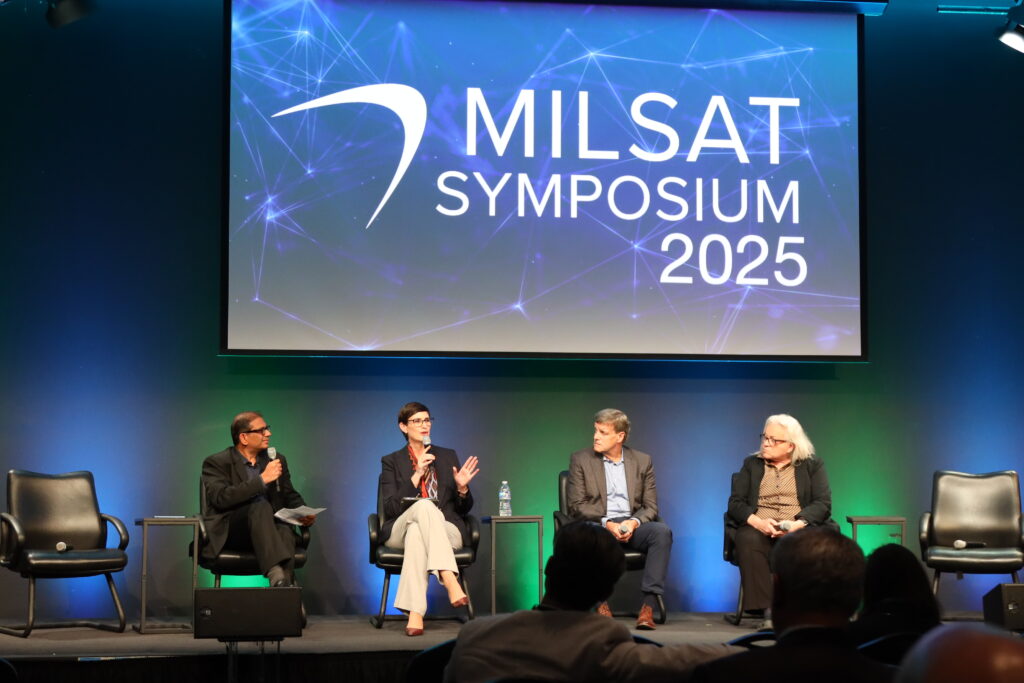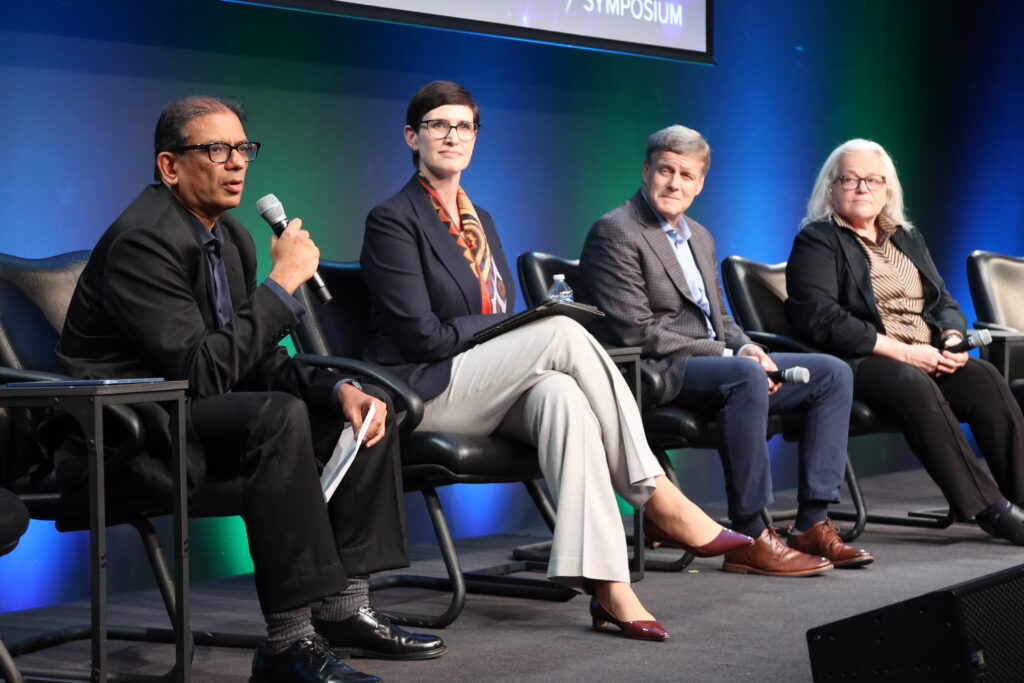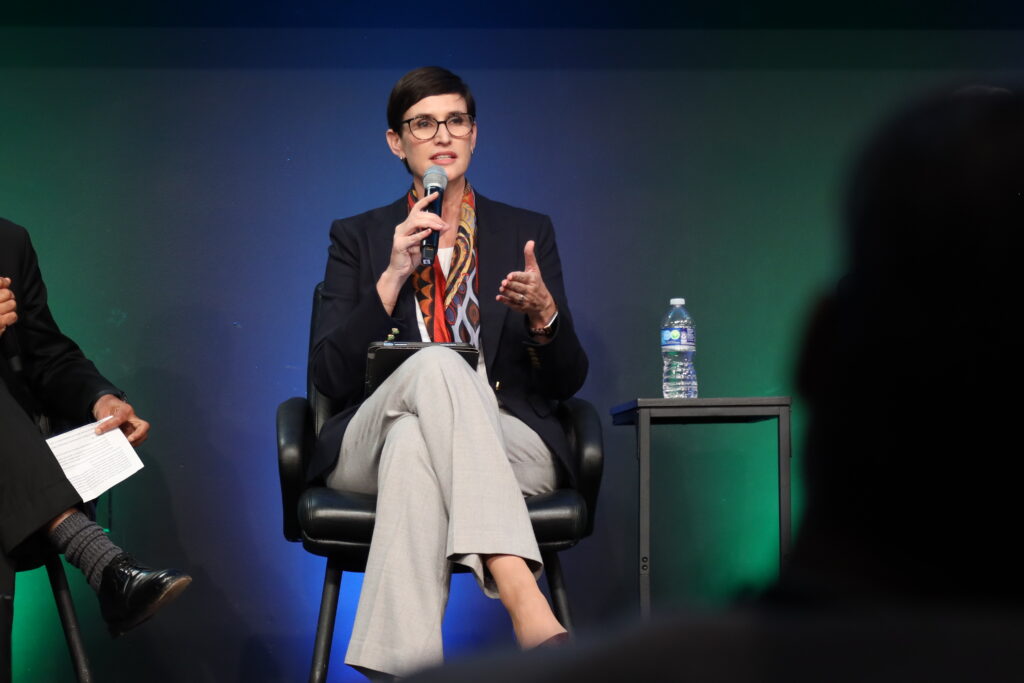By Chris Forrester

There were apologies all around because of the US government shut-down meant that actual military personnel at the Silicon Valley Space Week’s Milsat Symposium on October 29 at Mountain View, were thin on the ground this year. Normally, the event has plenty of uniformed and more casually dressed military participants. However, moderator Ahsun Murad (Co-founder/President & CEO at Optimal Satcom) promised delegates that his panel would more than cover the missing attendees with their skills and insights. Murad’s expertise covers civilian and military users, both US and foreign, so he promised a valued perspective to the question of Spectrum at the Crossroads: Commercial Ambitions, Government Priorities and Global Gaps. Chris Forrester reports.
Murad’s panel were certainly capable of important insight and comprised Janna Lewis (SVP of Policy & General Counsel, Astroscale U.S.); David Radi (VP/Government Solutions, Omnispace, but who in a ‘previous life’ had been an intelligence Naval officer) and Randy Segal (Partner at Hogan Lovells US LLP) and who – in one life or another – had worked in the sector for some 35 years.
Murad highlighted a pair of massive spectrum deals this year which involved EchoStar (AT&T for $23 billion, and the $17 billion with SpaceX) and thus proving the value of spectrum and surprising many observers. He asked his panel how they saw the transactions. Randy Segal suggested that the two deals should be separated, saying that the AT&T terrestrial transaction was dependent on well-understood and traditional valuations of $/MHz ‘pop’ and was a relatively straightforward calculation. The satellite deal with SpaceX was a very different creature and was a much more complicated calculation and concerned filing priorities, regional priorities, GSO vs NGSO, bringing the spectrum into use, and the perspective of actually selling satellite spectrum.

Segal added that this was the first time that there had been a significant sale of satellite spectrum to be used in a novel venture such as that planned by SpaceX. She reminded delegates that the recent deal between Ligado and AST SpaceMobile and cash paid to clear spectrum, and then for the spectrum to be shared by different users (including Inmarsat, Ligado and AST). She stated that Charlie Ergen’s sale of S-band spectrum – as with L-band – was extremely valuable because of the nature of where the spectrum sits within the band. It can close the communication link, and thus is quite valuable. The challenge now comes from the regulators and their approvals or modifications to the scheme and include power transmissions which might end up at the ITU and thus is much more complex. “The SpaceX spectrum purchase was a very big number”.
Omnispace’s David Radi told delegates that his company was sitting on 60 MHz of S-band spectrum, and whether worth $17 billion, or $19 billion, “We – in the past – had asked ourselves why didn’t people see value in that spectrum”. He added that now he had a bigger smile on his face!
Omnispace’s business model is Direct-To-Device, whether IoT, or handheld, it was important. He admitted that his spectrum wasn’t going to support movie streaming but for government applications it was perfect and could serve many purposes. It was also good for automotive.
Murad added that LEO and MEO, both being global, were no longer regional players (as GEO is). He asked the panel what this meant in terms of challenges. Astroscale’s Janna Lewis said her aim was to secure spectrum for specific applications and gave as an example ‘on-orbit servicing’ that simply had not been imagined. “We look for opportunities, but we talk to the FCC and ITU about spectrum and is a core part of our business.”
Lewis said that the time-scale for any sort of change, and the ITU is typical, “was glacial”. The ITU only meets every 3 to 4 years to take a fresh look at spectrum allocations and whether there was a need to update what – in essence – were treaties between nations. Those decisions flow down to the sovereign nations.

Segal stressed that the world had not ended for geostationary satellites. Broadcast, satellite radio, satellite TV and other broadcast services and for nations which just want to cover their country, all depend on Geo. In fact the smaller geo satellites now being developed, which are less costly, can suit much better than LEO. So, that spectrum is still being used and is important. Moreover, that country being served is not going to let go of that spectrum. This affects new systems coming up, new services coming into play, and NGSO needs but you still have GSO systems that are needed. Indeed, the simple laws of physics have not allowed these demands to co-exist. She reminded delegates of the needs of the International Space Station and the growing number of commercial space stations, and their demands on sending and receiving messages. It means you have spectrum demands at GEO, MEO, LEO, VLEO and even on drones and High Altitude Platforms (HAPS) that need spectrum. She said the industry needed solutions, such as laser/optical developments which could help.
Radi then raised the topic of the half-ton Gorilla in the room, and the obvious problem of interference, and how to mitigate that interference. “It has to be worked out,” he argued. Omnispace is in the process to merging with Lynk Global under the helpful stewardship of SES which will then be a major investor in the resulting business. Radi said Omnispace’s frequencies are “right next” to an ordinary cellphone’s frequencies. “Bringing all this together is critical and key to our success with our investment,” he added.
Murad asked his panel what the differences were between the other Direct-to-Device players including Starlink, AST, Lynk, Iridium, Apple/Globalstar and Viasat. “What are their strategies, and do they have the spectrum,” he asked. Segal reminded delegates that the D2D ambition is not new and had been around for many years with Ligado (formerly known as LightSquared) but it never came to fruition. Omnispace uses satellite spectrum for D2D. AST’s model began with MVNOs (the Vodafones and AT&Ts of the world) who would use their own spectrum to tap into the AST system. AST use of L and S-band would supplement that activity. The Apple/Globalstar model is not wholly clear how their relationship with T-Mobile would be used. Starlink is different again.
“But key to all this is the chipset. You must have a chipset which works and where the cellular operators and the satellites work together to make a service happen,” Segal added, but also expressed the view that she saw Europe’s D2D strategy being different again, and a European partnership emerging. She said that she expected Europe to remove the S-band frequencies from EchoStar because they were not used. “It is the same with L-band, because other than Inmarsat there’s nobody using the wonderful L-band around the globe, although the Viasat scheme (with Space42) could make use of it.”
Omnispace also admitted that while it had its 60 MHz of spectrum, it was not available over North America or Europe, so SES was expected to have to help to “crack that nut”. Radi added that Lynk is building its own satellites and the backing of SES will be extremely helpful overall.
Nevertheless, the panel was optimistic. It barely had time to discuss the spectrum needs of ‘in-orbit’ servicing and where the ‘space tug’ would cross orbits and frequencies, or the upcoming satellite C-band FCC 2027 auction, or reversing the “glacial” progress of some of the world’s regulators. But they were optimistic.
